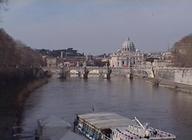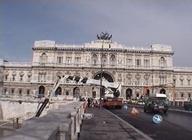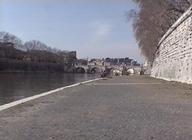


Piazza del Popoli. As in many Roman piazzas, there was a huge Egyptian obelisk located in the center. As usual, there was a cross put on the tip of the obelisk. The statues were somewhat neptunic, but I don't know anything about their origins.
Sounds from the streets (MP3, 480kB, 30s).
The museum for John Keats and Shelley is located just at the base of the famous Piazza di Spagna and Spanish Steps. I went to visit the John Keats museum, because I had read about him in the science fiction book Hyperion by Dan Simmons, which is largery based on Keats's life and poetry. Not that I am were very fond of poetry or anything though. The museum is located in the second-floor apartment where John Keats came to treat his consumption, but died soon after. Unfortunately, photography wasn't allowed inside.
Sounds from Piazza di Spagna (MP3, 170kB, 10s).
The Pantheon is a building of unique architecture that was begun in 27 BCE by the statesman Marcus Vipsanius Agrippa, but it was completely rebuilt by Hadrian around 120 CE. It was dedicated to the pantheon - ''all the gods''. This meaning was, however, to be perverted totally by the monotheists. On year 609 CE, the building was dedicated as Church of the Santa Maria Rotonda, and more generally Christian martyres, which it remains today.
Sounds from the Pantheon (MP3, 490kB, 30s).
On monday the 21st day, I went to the Church of Santa Maria Sopra Minerva. In the plaza in front of the church was this elephant obelisk.
It had very beautiful round mosaic windows.
And some nice sculptures. Hmm...if they were sculptures at all...
In floor plan of the church there was an interesting note written by hand with a pencil: ''Qui abi... Galileo nel 1633.'' According to what I heard, this refers to the location where Galileo was ordered to repent and deny his heresies in 1633, only a few decades later from Giordano Bruno.
On monday I took a taxi - a real one this time - to see the Piramide and the Protestant graveyard near the Via Ostiense. The 36.4 meters high marble pyramid was built as a sepulcher (tomb) for praetor Gaius Cestius in the end of the first century BCE. Surrounding the pyramid is the wall built by Marcus Aurelius around 270 CE to defend Rome.
Behind the pyramid was the Protestant Graveyard, where John Keats's and Shelley's tombs were located. Unfortunately, the graveyard was closed on mondays. Keats's tomb is famous because it has no name, but only text: ''Here rests he whose name was writ on water.'' Or something like that, some silly poet stuff...
There were these ruins somewhere between the pyramid and Colosseum, but it wasn't on my map so I don't know what it was. Anyhow, it was closed on monday the 21st, when I was there.
This is something like Piazza San Giovanni in Laterano. I don't know what the building was.
There was a Salvador Dali exhibition in one place.
I think this pillar was on Piazza Colonna.
I managed to add to my international collection of beggars in Rome. The overweight lady on the right side had a very distinct waving movement with her hand.


 Last modified: Mon Feb 28 16:14:23 EET 2000
Last modified: Mon Feb 28 16:14:23 EET 2000